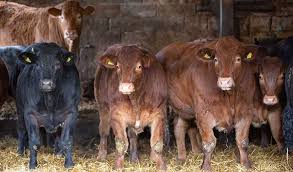The Beef Cattle Institute - February 27, 2023
Cattle are an amazing animal species for many reasons. One of the most important reasons is because they can thrive when fed a wide variety of diets and feedstuffs. Because of the rumen, cattle are able to utilize forages that are not appropriate for simple-stomach animals; in addition, cattle can eat grains, by-products of grain processing, and waste from human food production. However, it is important to know that if diets are changed without an adaptation period or if cattle have sudden access to a new feedstuff, health problems can follow.
Changing form one roughage source to another or from a high-grain, concentrate diet to a roughage diet is usually well-tolerated; in contrast, suddenly changing from a roughage diet to a concentrate diet can be accompanied by acidosis, a serious digestive problem in grain-fed animals. In cow-calf operations, cattle are rarely intentionally fed a diet consisting primarily of grains, but sometimes growing bulls or heifers are fed a high-grain diet, and cows may have the opportunity to consume more gain than the producer intends when grain is used to supplement low-quality, dormant forage.
Acidosis can occur following a large meal of feed rich in readily fermentable carbohydrates that causes the rate of lactic acid production in the rumen to exceed how quickly it can be used. Cereal grains such as wheat, barley, corn, sorghum (and to a lesser extent oats) as well as high sugar or starch content fruit or root crops (apples, potatoes, sugar beets etc.) are associated with acidosis. Green, unripe corn, corn or milo stubble fields, and byproduct feeds such as bakery waste, elevator fines, and some brewer’s grains are also high in starch or simple sugars making cattle eating these feeds also at risk for acidosis. Feeds that are not likely to induce acidosis are hay and fiber-type byproduct feeds. Hay does not contribute to acidosis because the energy source is mostly cellulose rather than simple sugars and the physical properties (large particle size) resist rapid fermentation. Fiber-type byproduct feeds such as soy hulls, distillers grains, or corn gluten feed are similar to hay in that the energy source is primarily cellulose with little starch or simple sugar present. Fine grinding of grain, rapid changes in the amount of grain or other high-starch feeds in the diet, or cattle that become hungry and then eat a large meal of grain are often implicated in the disease.
Cattle that are suffering from acidosis can look a lot like cattle with respiratory disease by showing a lack of appetite, slow movement, increased heart rate and breathing rate, and elevated body temperature. In mild cases of acidosis, cattle will appear to have a full rumen, they may act uncomfortable due to a sore belly, and will probably have grey-green pasty to soupy diarrhea. In more severe cases, dehydration is severe, the animal will usually be laying down, the abdomen is markedly distended, and the animal is noticeably uncomfortable (groaning and grinding of teeth). Diarrhea is profuse and yellow-green and then progresses to watery, often foamy with a pungent odor. Death commonly follows severe cases. Cattle that recover from acidosis may develop liver abscesses, laminitis, or other secondary diseases.
Mild cases of acidosis are commonly treated by removing the feed causing the problem and possibly administering a buffer by stomach tube. Treatment of more serious cases may include siphoning off ruminal contents with a stomach tube or surgically opening the rumen and removing the rumen contents followed by re-inoculation of fresh rumen contents from a healthy animal. In addition, large volumes of intravenous (IV) fluids are given. In this disease process, IV fluids must be used because fluids given by mouth (via stomach tube) will not be absorbed from the rumen into the rest of the body.
Acidosis is prevented through feeding management that avoids a sudden increase in intake of grain or other readily fermentable feeds, sufficient bunk space so that aggressive eaters don’t have access to feed amounts intended for several animals, and good bunk management so that cattle are not overly hungry. In addition, inclusion of an ionophore in the ration helps to decrease the incidence and severity of acidosis.













